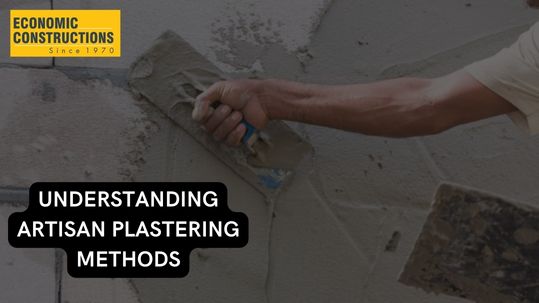
27 Jun Understanding Artisan Plastering Methods: A Complete Guide for Residential Construction
In residential construction, achieving flawless finishes is important for creating aesthetically pleasing and durable spaces. Economic Constructions, a leading construction company in Chennai, recognizes the significance of mastering artisan plastering techniques to elevate the quality of their projects. This blog aims to delve into the various aspects of artisan plastering, covering plaster types, mixing ratios, application methods, and the intricacies of achieving smooth, textured, or decorative finishes. We’ll also explore the critical curing, sanding, and sealing plaster processes to ensure a flawless end result.
1. Understanding Plaster Types:
Artisan plastering involves different types of plaster, each serving specific purposes.
Lime Plaster: Known for its breathability and flexibility, lime plaster is ideal for historical or restoration projects. It allows the walls to absorb and release moisture, preventing issues like mold growth.
Gypsum Plaster: This type of plaster is popular for its quick-drying properties. It’s suitable for interior walls and ceilings, providing a smooth surface for further finishes.
Cement Plaster: Durable and resistant to water, cement plaster is often used in areas prone to high moisture levels, such as bathrooms and kitchens. It provides a robust base for tile and paint finishes.
2. Perfecting Mixing Ratios:
Achieving the right consistency is crucial for a successful plaster application. Economic Constructions follow precise mixing ratios to ensure optimal adhesion and strength. The ratios vary depending on the plaster used, and strict adherence to manufacturer guidelines is a priority.
3. Application Methods:
The application method plays a significant role in the final finish. Economic Constructions employs skilled artisans who are adept at various techniques:
Trowel Application: Ideal for achieving a smooth and polished finish, trowel application requires a steady hand and experience to avoid streaks or imperfections.
Texturing Techniques: For textured or decorative finishes, artisans may use techniques such as sponge floating, stippling, or combing to create unique patterns and designs.
4. Achieving Smooth, Textured, or Decorative Finishes:
Smooth, textured, and decorative finishes contribute to the overall aesthetic of a space. Economic Constructions understands the importance of catering to diverse client preferences and project requirements. Whether it’s a sleek modern finish, a rustic textured look, or intricate decorative patterns, the artisans have the expertise to deliver.
5. Curing, Sanding, and Sealing:
The curing process is critical for plaster to achieve its maximum strength. Economic Constructions follows a meticulous curing timeline to ensure the longevity of the plaster. Once cured, the surface undergoes careful sanding to eliminate imperfections and create a flawless canvas. Sealing is the final step to protect the plaster from moisture, stains, and wear. Economic Constructions utilizes high-quality sealants to enhance durability and facilitate easy maintenance.
Mastering artisan plastering techniques is an art that Economic Constructions, a reputed construction company in Chennai, takes pride in. By prioritizing the right plaster types, mixing ratios, application methods, and finishing processes, they consistently deliver flawless results that exceed client expectations. In the world of residential construction, where attention to detail is paramount, Economic Constructions, the best builder in Chennai stands as a testament to the importance of craftsmanship in creating exceptional living spaces.

No Comments